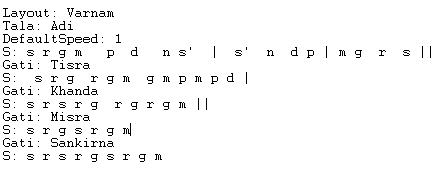Carnatic Music Notation Typesetter – Release v1.5 Beta
The 1.5 release of the Carnatic Music Notation Typesetter is now released in beta mode. Click on the following links to launch application, view the manual and view the sample notation files.
This release contains the following enhancements:
- A Smart Lyric mode, which allows you to specify lyrics more easily. See the SmartLyricMode directive section of the manual.
- Enhancements to manual mode in tala. There are now two manual modes, one of which places tala anga markers above the notation line which can allow for closer grouping of swaras that are part of a single musical phrase. This allows for the underlying melody to be more easily discerned from the notation. See the Tala directive section of the manual.
- Support for rendering language using Roman diacritics – see the Language directive section.
- Better control over the width and height of margins around the content can be controlled. See the Orientation directive section of the manual.
- A new Title directive to specify the title of the web-page. This can be useful in printing as the browser can be directed to put this information in the header/footer sections.
The release also has some bug fixes with respect to layout and pagination.
Pagination behavior change: Due to lack of reliable pagination control (as well as browser incompatiblities), starting with v1.5 Beta, the typesetter does not automatically paginate contents like in earlier versions (since that has proven to be very unreliable). The typesetter now instead relies on the browser’s printing capabilities itself. This may however result in browser inserting a page break at inappropriate places (e.g. between the swara line and the corresponding lyric line). To fix these, you can insert the Pagebreak directive to introduce a manual pagebreak.

 button. To load input from a file, click on the
button. To load input from a file, click on the  button. Please note the following that both open and save operations require the notation input to be sent to the server and back (Note: This is the recommended way a web-application should implement open/save, and it also is the most portable in terms of usability with different browsers).
button. Please note the following that both open and save operations require the notation input to be sent to the server and back (Note: This is the recommended way a web-application should implement open/save, and it also is the most portable in terms of usability with different browsers). instead of
instead of  ) . Also, based on your preference, you may explicitly specify s2 to direct the typesetter to use the alternate Tamil sa phoneme character (
) . Also, based on your preference, you may explicitly specify s2 to direct the typesetter to use the alternate Tamil sa phoneme character ( ) rather than the standard sa/ca phoneme character (
) rather than the standard sa/ca phoneme character ( ). While such inputs will display as intended when rendered in Tamil, if there is a need to also see them in English, then the n2s, ^ns, and s2s are not meaningful, and can make the text less readable. Hence, the typesetter output prunes these out when displaying in English..
). While such inputs will display as intended when rendered in Tamil, if there is a need to also see them in English, then the n2s, ^ns, and s2s are not meaningful, and can make the text less readable. Hence, the typesetter output prunes these out when displaying in English..


 . This character, while not as widely accepted in Tamil, is nevertheless common in Tamil books (e.g. music books, religious books) that need to represent non-Tamil sources. It is a fairer representation of the Sa phoneme (as in Siva, Sakti) compared to
. This character, while not as widely accepted in Tamil, is nevertheless common in Tamil books (e.g. music books, religious books) that need to represent non-Tamil sources. It is a fairer representation of the Sa phoneme (as in Siva, Sakti) compared to  /
/